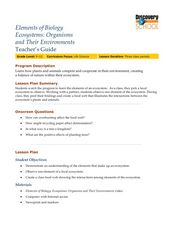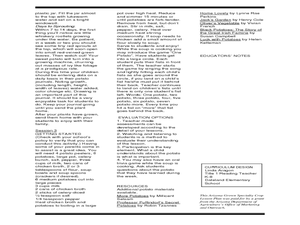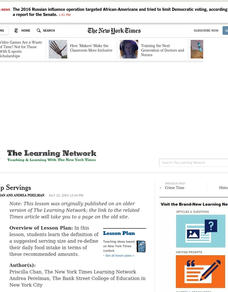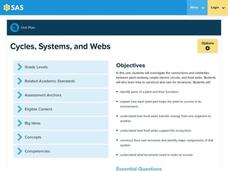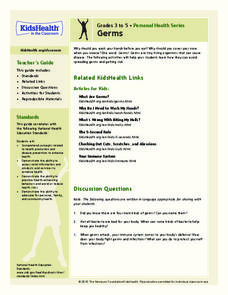Curated OER
Organisms and Their Environments
Students study a local ecosystem and research the organisms to create a food web. In this ecosystem instructional activity, students view a video and answer questions. They visit a local ecosystem and make a list of organisms to...
Curated OER
From Mashed to Riches
Students discuss the uses of a potato. In this food group lesson, students identify the five food groups and which one the potato belongs to. They create potato printing, compare different kinds of potatoes, grow a potato plant, and more.
Curated OER
What's the Shape of Your Diet?
Fifth graders explore the food pyramid. In this food pyramid lesson, 5th graders investigate a proper balanced diet and compare their daily diet with recommendations from the food pyramid. Students create a visual representation of their...
Curated OER
Understanding MyPlate
Sixth graders recognize how using the food pyramid can add to their good health practices. In this food pyramid lesson, 6th graders build a 3-D food pyramid illustrating the desired amount of each food group.
Curated OER
Field Trip to the Watsonville Wetlands
Young scholars explore the differences between food webs and food chains. In this wetland lesson students play a food web game and go on a scavenger hunt.
Curated OER
Who Eats Who?
Learners recognize that some animals eat plants, some eat meat and some both. In this who eats who lesson, students chart animals in a food chain. Learners research information from reading articles. Students chart what...
Curated OER
"Wet" Your Appetite: Conserving Water
Students investigate how water is utilized in producing food. In this agriculture lesson, students examine how much water goes into the creation of their daily menu. Students create a new menu that can conserve water and cut their water...
Curated OER
Sizing Up Servings
Students learn the definition of a suggested serving size and re-define their daily food intake in terms of these recommended amounts.
Curated OER
Fruitful Questions
Learners examine a fruit-related Q & A Science Times article. They write their own food science questions and answer them in the same format as the article. For homework, they analyze their fruit consumption according to U.S....
Curated OER
Something Fishy - Bioaccumulation of Mercury
Students explore the dangers of eating high levels of mercury and how small amounts of mercury in water accumulate in greater quantities in organisms higher in the food chain. They list the health of effects of high levels of mercury on...
Curated OER
Who Gives a Hoot?
Students look at owl migration and its impact on the environment and the food chain after reading an article from The New York Times. Students then apply this information to and research different food chain situations for other species...
Curated OER
Texas Ecoregions Summary Sheet
In this ecoregions of Texas worksheet, students complete a summary of a particular ecoregion in Texas. They find the producers and consumers of the region, they draw a food chain, the draw a food web, and they complete an energy pyramid...
Curated OER
Measuring Calories
Students burn peanuts and marshmallows to determine the calories each contains. In this calorimetry instructional activity, students set up an apparatus with a ring stand and water in an aluminum can. They record the temperature of the...
Curated OER
Microorganisms: Good Guys or Bad Guys?
Learners discover the role microorganisms play in our lives. In this decomposition activity, students examine decaying foods and plants in order to analyze the different bacteria that grows. Learners discuss the good and bad of...
Curated OER
The Frog and the Ol' Black Fly
Students explore frogs. For this cross curriculum literacy and frogs lesson, students predict the plot and then listen to the book The Wide-Mouthed Frog by Keith Faulkner. Students define "predator" and identify foods a frog might...
Curated OER
Eating Out and Eating In- Go Lean with Protein
Fifth graders explore healthy food options at fast food restaurants. In this restaurant lesson plan, 5th graders explore menus from different fast food options. Students investigate menus to determine the healthiest meal options.
Curated OER
Breaking It Down
Seventh graders explain the mechanism of digestion. In this biology lesson, 7th graders perform an iodine test to check for the presence of starch. They discuss how energy travels through the food chain.
Curated OER
Coral Reef Community
Students explore the coral reef. In this food chain lesson plan, students study the plants and animals of the coral reef and how they each play a role in that ecosystem. They participate in a class play to demonstrate the types of...
Pennsylvania Department of Education
Cycles, Systems, and Webs
Fourth graders review the parts of the plant and their functions. In this plant lesson, 4th graders recognize that plants must transfer energy to make food. Students understand the interdependence of organisms in an...
Curated OER
Shark Attack Odds and the Importance of Sharks
Students examine an ecosystem. In this food web lesson, students discover the importance of sharks and what threat sharks actually pose to humans. They participate in class discussions and work independently on a couple of different...
Curated OER
Testing for Vitamin C in Different Drinks and Foods
Students examine the importance of vitamin c in their diets and the sources that it comes from. In this vitamin lesson students complete hands on activities, interpret data and make a bar graph.
Curated OER
A Day on the Farm
First graders, with a collection of various art supplies, plant a seed to observe it growing and record specific data on a data record sheet. They create a collage from various magazines of ten different foods farm animals eat and make a...
Nemours KidsHealth
Germs: Grades 3-5
Young scholars investigate personal health issues by discussing germs. For this contagious disease lesson plan, students identify ways germs infect our bodies and how we can best protect ourselves. Young scholars discuss food...
Curated OER
From Eggs to Frogs
Third graders receive a small container of tapioca pudding, they are to pretend that it is frog eggs. The students pretend they are birds who see the eggs, and eat some of them. They discuss what would happen if these were really frog...
Other popular searches
- Food Pyramid
- Food Chains
- Food Groups
- Food Webs
- Food Labels
- Food Safety
- Desert Food Chain
- Esl Lessons Food
- Animal Food Chain
- Deciduous Forest Food Chains
- Nutrition Labels
- Healthy Foods
